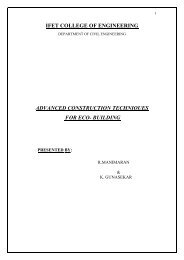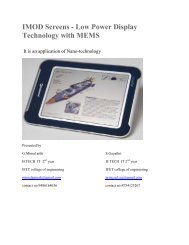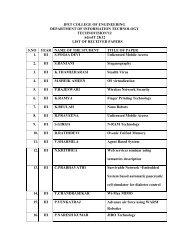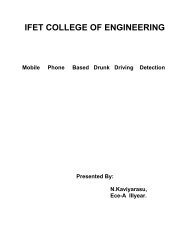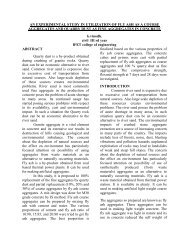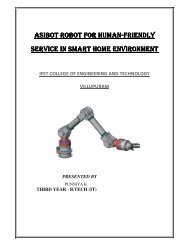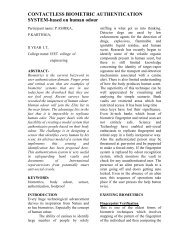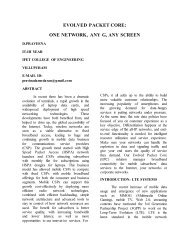brain controlled car for disabled using artificial intelligence
brain controlled car for disabled using artificial intelligence
brain controlled car for disabled using artificial intelligence
You also want an ePaper? Increase the reach of your titles
YUMPU automatically turns print PDFs into web optimized ePapers that Google loves.
I.F.E.T COLLEGE OF ENGINEERING<br />
VILLUPURAM-605602<br />
BRAIN CONTROLLED CAR FOR<br />
DISABLED USING<br />
ARTIFICIAL INTELLIGENCE<br />
Authors:<br />
B.Dharaneswer reddy,<br />
3 rd year ,<br />
E.C.E
1. ABSTRACT<br />
This paper considers the<br />
development of a <strong>brain</strong> driven <strong>car</strong>, which<br />
would be of great help to the physically<br />
<strong>disabled</strong> people. Since these <strong>car</strong>s will rely<br />
only on what the individual is thinking they<br />
will hence not require any physical<br />
movement on the part of the individual. The<br />
<strong>car</strong> integrates signals from a variety of<br />
sensors like video, weather monitor, anticollision<br />
etc. it also has an automatic<br />
navigation system in case of emergency. The<br />
<strong>car</strong> works on the asynchronous mechanism<br />
of <strong>artificial</strong> <strong>intelligence</strong>. It’s a great advance<br />
of technology which will make the <strong>disabled</strong>,<br />
abled. In the 40s and 50s, a number of<br />
researchers explored the connection between<br />
neurology, in<strong>for</strong>mation theory, and<br />
cybernetics. Some of them built machines<br />
that used electronic networks to exhibit<br />
rudimentary <strong>intelligence</strong>, such as W. Grey<br />
Walter's turtles and the Johns Hopkins Beast.<br />
Many of these researchers gathered <strong>for</strong><br />
meetings of the Teleological Society at<br />
Princeton and the Ratio Club in England.<br />
Most researchers hope that their work<br />
will eventually be incorporated into a<br />
machine with general <strong>intelligence</strong> (known as<br />
strong AI), combining all the skills above<br />
and exceeding human abilities at most or all<br />
of them. A few believe that<br />
anthropomorphic features like <strong>artificial</strong><br />
consciousness or an <strong>artificial</strong> <strong>brain</strong> may be<br />
required <strong>for</strong> such a project.<br />
2. INTRODUCTION<br />
The video and thermo gram<br />
analyzer continuously monitor activities<br />
outside the <strong>car</strong>. A <strong>brain</strong>-computer<br />
interface (BCI), sometimes called a direct<br />
neural interface or a <strong>brain</strong>-machine<br />
interface, is a direct communication<br />
pathway between a human or animal <strong>brain</strong><br />
(or <strong>brain</strong> cell culture) and an external device.<br />
In one-way BCIs, computers either accept<br />
commands from the <strong>brain</strong> or send signals to<br />
it (<strong>for</strong> example, to restore vision) but not<br />
both. Two-way BCIs would allow <strong>brain</strong>s<br />
and external devices to exchange<br />
in<strong>for</strong>mation in both directions but have yet<br />
to be successfully implanted in animals or<br />
humans.
In this definition, the word <strong>brain</strong><br />
means the <strong>brain</strong> or nervous system of an<br />
organic life <strong>for</strong>m rather than the mind.<br />
Computer means any processing or<br />
computational device, from simple circuits<br />
to silicon chips (including hypothetical<br />
future technologies such as quantum<br />
computing) once the driver (<strong>disabled</strong>) nears<br />
the <strong>car</strong>. The security system of the <strong>car</strong> is<br />
activated. Images as well as thermo graphic<br />
results of the driver are previously fed into<br />
the database of the computer. If the video<br />
images match with the database entries<br />
then the security system advances to the<br />
next stage. Here the thermo graphic image<br />
verification is done with the database.<br />
Once the driver passes this stage the door<br />
slides to the sides and a ramp is lowered<br />
from its floor. The ramp has flip actuators<br />
in its lower end. Once the driver enters the<br />
ramp, the flip actuates the ramp to be lifted<br />
horizontally. Then robotic arms assist the<br />
driver to his seat. As soon as the driver is<br />
seated the EEG (electroencephalogram)<br />
helmet, attached to the top of the seat, is<br />
lowered and suitably placed on the driver’s<br />
head. A wide screen of the computer is<br />
placed at an angle aesthetically suitable to<br />
the driver. Each program can be <strong>controlled</strong><br />
either directly by a mouse or by a shortcut.<br />
For starting the <strong>car</strong>, the start button is<br />
clicked. Accordingly the computer<br />
switches ON the circuit from the<br />
battery to the A.C.Series Induction<br />
motors.<br />
3. BIOCONTROL SYSTEM<br />
The biocontrol system<br />
integrates signals from various other<br />
systems and compares them with originals<br />
in the database. It comprises of the<br />
following systems:<br />
Brain-computer interface<br />
Automatic security system<br />
Automatic navigation system<br />
Now let us discuss each system in detail.<br />
3.1. BRAIN – COMPUTER INTERFACE<br />
Brain-computer interfaces<br />
will increase acceptance by offering<br />
customized, intelligent help and<br />
training, especially <strong>for</strong> the non-expert user.<br />
Development of such a flexible interface<br />
paradigm raises several challenges in the<br />
areas of machine perception and<br />
automatic explanation. The teams doing<br />
research in this field have developed a<br />
single-position, <strong>brain</strong>-<strong>controlled</strong> switch<br />
that responds to specific patterns detected<br />
in spatiotemporal electroencephalograms
(EEG) measured from the human scalp.<br />
We refer to this initial design as the Low-<br />
Frequency<br />
Asynchronous Switch Design<br />
(LF-ASD)<br />
Full image capture and playback<br />
control; user configurable.<br />
The EEG is then<br />
filtered and run through a fast Fourier<br />
trans<strong>for</strong>m be<strong>for</strong>e being displayed as a three<br />
dimensional graphic. The data can then<br />
be piped into MIDI compatible music<br />
programs. Furthermore, MIDI can be<br />
adjusted to control other external<br />
processes, such as robotics. The<br />
experimental control system is configured<br />
<strong>for</strong> the particular task being used in the<br />
evaluation. Real Time Workshop generates<br />
all the control programs from Simulink<br />
models and C/C++ <strong>using</strong> MS Visual C++<br />
6.0. Analysis of data is mostly done<br />
within Mat lab environment.<br />
Fig. 2: EEG Transmission<br />
Fig. 3 EEG<br />
3.1.1. TEST RESULTS COMPARING<br />
DRIVER<br />
ACCURACY<br />
WITH/WITHOUT BCI<br />
1. Able-bodied subjects <strong>using</strong><br />
imaginary movements could attain<br />
equal or better control accuracies than<br />
able-bodied subjects <strong>using</strong> real
movements.<br />
2. Subjects demonstrated activation<br />
accuracies in the range of 70-82% with<br />
false activations below 2%.<br />
3. Accuracies <strong>using</strong> actual finger<br />
movements were observed in the<br />
range 36-83%<br />
4. The average classification accuracy<br />
of imaginary movements was over<br />
99%<br />
neuron. These motor neurons <strong>car</strong>ry the<br />
signal to the physical components such<br />
as hands or legs. Hence we decode the<br />
message at the motor neuron to obtain<br />
maximum accuracy. By observing the<br />
sensory neurons we can monitor the eye<br />
movement of the driver.<br />
Fig.5 Eyeball Tracking<br />
Fig.4 Brain-to- Machine<br />
Mechanism<br />
The principle behind the<br />
whole mechanism is that the impulse of<br />
the human <strong>brain</strong> can be tracked and even<br />
decoded. The Low-Frequency<br />
Asynchronous Switch Design traces the<br />
motor neurons in the <strong>brain</strong>. When the<br />
driver attempts <strong>for</strong> a physical movement,<br />
he/she sends an impulse to the motor<br />
As the eye moves, the cursor<br />
on the screen also moves and is also<br />
brightened when the driver concentrates<br />
on one particular point in his environment.<br />
The sensors, which are placed at the front<br />
and rear ends of the <strong>car</strong>, send a live<br />
feedback of the environment to the<br />
computer. The steering wheel is turned<br />
through a specific angle by<br />
electromechanical actuators. The angle of<br />
turn is calibrated from the distance<br />
moved by the dot on the screen.
activates the program <strong>for</strong> automatic drive.<br />
If the driver is doesn’t give reply then the<br />
computer prompts the driver <strong>for</strong> the<br />
destination be<strong>for</strong>e the drive.<br />
Fig.6 Electromechanical Control Unit<br />
3.3. AUTOMATIC NAVIGATION<br />
SYSTEM<br />
As the computer is based<br />
on <strong>artificial</strong> <strong>intelligence</strong> it automatically<br />
monitors every route the <strong>car</strong> travels and<br />
stores it in its map database <strong>for</strong> future use.<br />
The map database is analyzed and the<br />
shortest route to the destination is chosen.<br />
With traffic monitoring system provided<br />
by xm satellite radio the computer drives<br />
the <strong>car</strong> automatically. Video and anticollision<br />
sensors mainly assist this drive by<br />
providing continuous live feed of the<br />
environment up to 180 m, which is sufficient<br />
<strong>for</strong> the purpose.<br />
Fig.7 Sensors and Their Range<br />
3.2. AUTOMATIC SECURITY<br />
SYSTEM<br />
The EEG of the driver is monitored<br />
continually. When it drops less than 4 Hz<br />
then the driver is in an unstable state. A<br />
message is given to the driver <strong>for</strong><br />
confirmation and waits <strong>for</strong> sometime, to<br />
continue the drive. A confirmed reply<br />
Fig.8 EEG Analysis Window
4. CONCLUSION<br />
When the above<br />
requirements are satisfied and if this <strong>car</strong><br />
becomes cost effective then we shall<br />
witness a revolutionary change in the<br />
society where the demarcation between the<br />
abler and the <strong>disabled</strong> vanishes. Thus the<br />
integration of bioelectronics with<br />
automotive systems is essential to develop<br />
efficient and futuristic vehicles, which shall<br />
be witnessed soon helping the <strong>disabled</strong> in<br />
every manner in the field of transportation.<br />
5. REFERENCE<br />
1. seminarprojects.com/Thread-<strong>brain</strong><strong>controlled</strong>-<strong>car</strong>-<strong>for</strong>-<strong>disabled</strong>^<br />
2. www.google.com<br />
3. www.wikipedia.com




